Alicante, a captivating coastal city nestled along the southeastern coast of Spain, invites you to delve into its rich tapestry of history, culture, and sun-kissed shores. With its ancient origins dating back to the Romans, Alicante has evolved into a vibrant metropolis that seamlessly blends its storied past with modern amenities, offering an unforgettable experience for every traveler.
From its awe-inspiring Santa Barbara Castle perched atop Mount Benacantil to its lively Postiguet Beach, Alicante enchants with its diverse attractions. Stroll through its charming old town, where narrow cobblestone streets lead to hidden plazas and architectural wonders, or immerse yourself in the city’s thriving art and culinary scenes. Alicante beckons you to uncover its many treasures, promising a journey that will leave a lasting impression.
History of Alicante
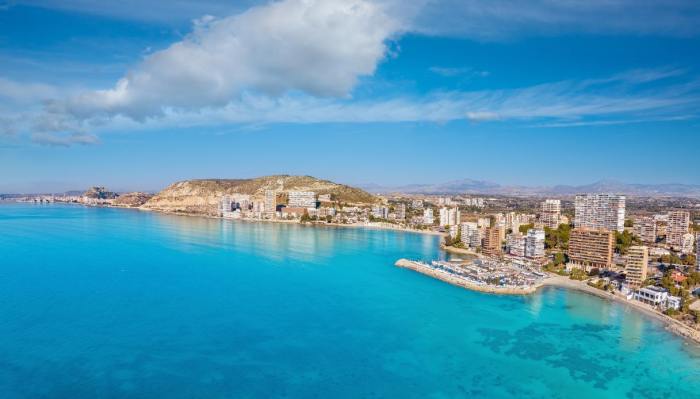
Alicante’s history dates back to the 3rd century BC when it was founded by the Carthaginians as a trading post. The city has been ruled by various empires over the centuries, including the Romans, Moors, and Spanish.
In the 13th century, Alicante became part of the Kingdom of Valencia. The city prospered during the Middle Ages and the Renaissance, becoming a major port and trading center. In the 16th century, Alicante was fortified by the Spanish to protect it from pirate attacks.
Major Periods of Growth
- 3rd century BC: Founded by the Carthaginians as a trading post.
- 1st century BC: Conquered by the Romans and renamed Lucentum.
- 5th century AD: Conquered by the Visigoths.
- 8th century AD: Conquered by the Moors and renamed al-Laqant.
- 13th century AD: Conquered by the Kingdom of Valencia.
- 16th century AD: Fortified by the Spanish to protect it from pirate attacks.
- 19th century AD: Became a major port and trading center.
- 20th century AD: Alicante experienced significant growth and development, becoming a major tourist destination.
Notable Figures
- Hamilcar Barca: Carthaginian general who founded Alicante in the 3rd century BC.
- Alfonso X of Castile: King of Castile who conquered Alicante in the 13th century AD.
- Jaime I of Aragon: King of Aragon who incorporated Alicante into the Kingdom of Valencia in the 13th century AD.
- Charles III of Spain: King of Spain who ordered the fortification of Alicante in the 16th century AD.
Architectural Landmarks
- Santa Barbara Castle: A medieval castle built by the Moors in the 9th century AD.
- Concatedral de San Nicolás de Bari: A Gothic-Renaissance cathedral built in the 16th century AD.
- Lonja de Alicante: A Renaissance-style market building built in the 16th century AD.
- Paseo de la Explanada: A promenade along the waterfront built in the 19th century AD.
Geography of Alicante

Alicante, a vibrant coastal city in southeastern Spain, boasts a picturesque geographical location. Nestled on the shores of the Mediterranean Sea, it is surrounded by a captivating landscape of mountains and rivers. The city’s proximity to these natural features has significantly influenced its development and character.
Geographical Location and Topography
Alicante lies on the southeastern coast of Spain, in the autonomous community of Valencia. It is situated on a narrow coastal plain, flanked by the Mediterranean Sea to the east and the Serra Grossa mountains to the west. The city’s topography is characterized by gentle hills and a series of small, rocky coves that line its coastline. The highest point within the city limits is the Tossal de Manises, standing at 129 meters above sea level.
Proximity to the Mediterranean Sea
Alicante’s proximity to the Mediterranean Sea has been a major factor in its history and economy. The city has a long maritime tradition and has served as an important port since ancient times. The Mediterranean Sea provides Alicante with access to global trade routes and has played a crucial role in the development of its tourism industry.
Surrounding Mountains and Rivers
Alicante is surrounded by a series of mountains, including the Serra Grossa, Serra de San Julián, and Serra de Bèrnia. These mountains provide a scenic backdrop to the city and offer opportunities for hiking, biking, and other outdoor activities. The city is also home to several rivers, including the Segura River, which flows through the northern part of Alicante. These rivers provide water for irrigation and contribute to the city’s lush vegetation.
Climate, Soil Conditions, and Natural Resources
Alicante enjoys a Mediterranean climate, with hot, dry summers and mild, rainy winters. The city receives an average of 280 days of sunshine per year. The soil conditions in Alicante are generally poor, consisting of a mixture of sand and clay. However, the city’s proximity to the sea and rivers has allowed for the development of fertile agricultural areas. Alicante’s natural resources include salt, marble, and limestone, which have been used in construction and other industries for centuries.
Culture of Alicante
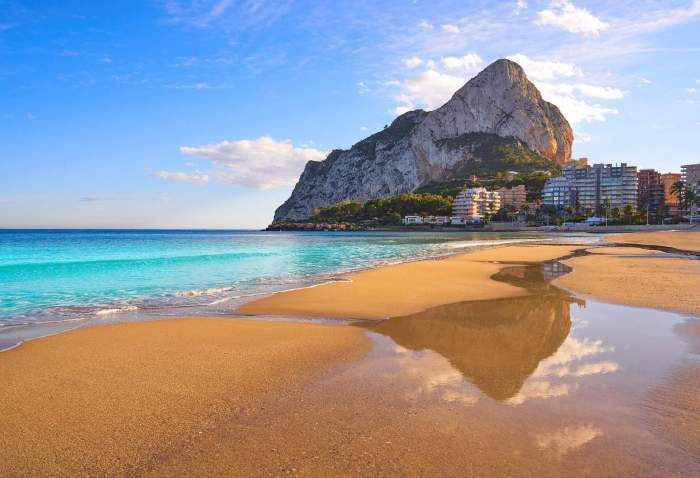
Alicante’s culture is a vibrant tapestry woven with influences from its rich history and diverse population. From traditional festivals to contemporary art, the city offers a captivating cultural experience.
The city’s traditions are deeply rooted in its past. The Moors, who ruled Alicante for centuries, left an enduring legacy in the city’s architecture, cuisine, and language. The Reconquista, when the Christians reconquered Spain from the Moors, brought new cultural influences that blended with the existing traditions.
Economy of Alicante
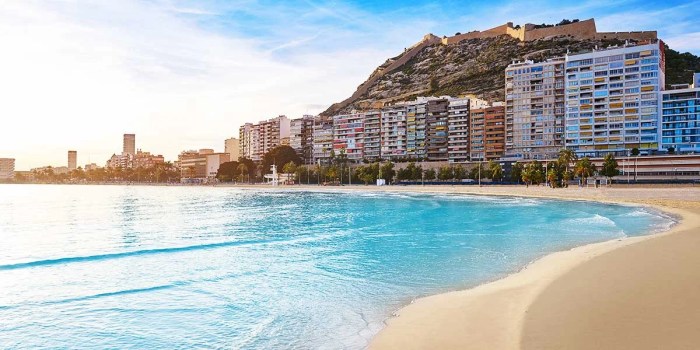
Alicante, a city on Spain’s southeastern coast, boasts a diverse and thriving economy. Its strategic location, excellent infrastructure, and skilled workforce contribute to its economic success.
Alicante’s economy is primarily driven by the service sector, which accounts for over 70% of its GDP. Tourism is a major industry, with the city attracting millions of visitors each year to its beautiful beaches, historic sites, and vibrant nightlife.
Major Industries
- Tourism
- Manufacturing
- Agriculture
- Financial services
li>Technology
Alicante is home to several large manufacturing companies, including Ford Motor Company, which has a major plant in the city. The city also has a strong agricultural sector, with oranges, grapes, and almonds being major crops.
Employment Sectors
The largest employment sectors in Alicante are:
- Services (65%)
- Industry (20%)
- Construction (10%)
- Agriculture (5%)
Alicante has a relatively low unemployment rate of around 10%, which is lower than the national average. The city’s economy has grown steadily in recent years, and it is expected to continue to grow in the future.
GDP and Economic Growth, Alicante
Alicante’s GDP is estimated to be around €20 billion. The city’s economy has grown by an average of 2% per year in recent years. This growth is expected to continue in the future, driven by the city’s strong tourism industry and its growing technology sector.
Alicante, a coastal city in Spain, is known for its stunning beaches and historic charm. If you’re looking for a tropical getaway, consider visiting Akumal , a small town on the Caribbean coast of Mexico. Akumal offers pristine beaches, crystal-clear waters, and abundant marine life.
Back in Alicante, you can explore the Santa Barbara Castle, wander through the charming old town, or relax on Postiguet Beach.
Architecture of Alicante
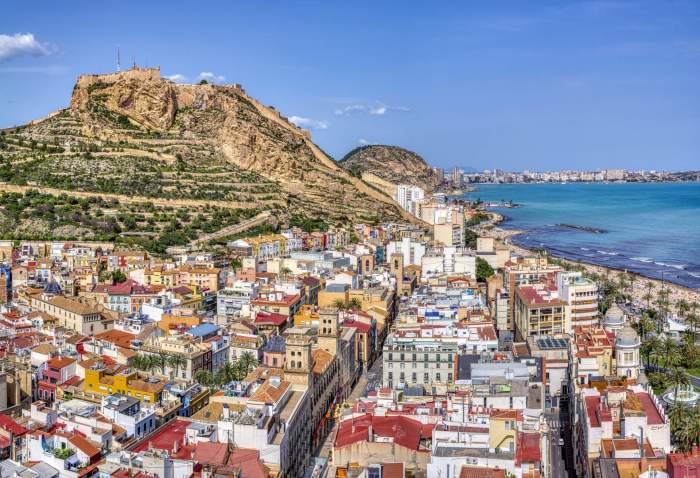
Alicante, Spain boasts a diverse architectural heritage that spans centuries, showcasing a harmonious blend of medieval, Renaissance, Baroque, and modern architectural styles. The city’s rich history is reflected in its architectural landmarks, from ancient fortifications to grand churches and contemporary skyscrapers.
Iconic Buildings
Among the most iconic buildings in Alicante is the Castillo de Santa Bárbara, a 16th-century fortress perched atop Mount Benacantil. Its imposing walls and towers offer breathtaking views of the city and the Mediterranean Sea. The Santa María Basilica, built in the 14th century, is a magnificent example of Gothic architecture, featuring intricate carvings and a stunning stained-glass window. The Baroque-style Town Hall, constructed in the 18th century, is renowned for its elegant facade and elaborate interior.
Notable Architects
Alicante has been home to several notable architects who have left their mark on the city’s architectural landscape. Juan Bautista Borja, a Valencian architect, designed the Baroque-style Palace of the Counts of Soto in the 18th century. Emilio Giménez, a local architect, played a significant role in the development of the city’s modern architecture during the 20th century. His works include the Postiguet Building, a modernist apartment complex, and the Casa Carbonell, a striking Art Deco building.
Tourism in Alicante

Tourism is a vital economic driver for Alicante, attracting millions of visitors each year. The city boasts stunning beaches, historical landmarks, and a vibrant cultural scene that caters to diverse interests.
Alicante’s beaches are a major draw, with Postiguet Beach being one of the most popular. The soft golden sand, crystal-clear waters, and picturesque promenade make it an ideal spot for sunbathing, swimming, and water sports. Other notable beaches include Albufereta Beach, Playa de San Juan, and Cabo de las Huertas.
Beyond its beaches, Alicante is home to a wealth of historical sites. The Santa Barbara Castle, perched atop Mount Benacantil, offers panoramic views of the city and surrounding coastline. The Castle of San Fernando, located on the outskirts of Alicante, is another impressive fortress with a rich history.
Alicante’s cultural offerings are equally impressive. The city is home to several museums, including the Museum of Contemporary Art (MACA) and the Archaeological Museum of Alicante (MARQ). The Explanada de España, a palm-lined promenade, is a popular gathering spot for locals and tourists alike.
Economic Impact
Tourism has a significant economic impact on Alicante. In 2019, the city welcomed over 3 million tourists, generating an estimated €1.5 billion in revenue. The tourism industry accounts for approximately 15% of Alicante’s GDP and supports over 30,000 jobs.
Transportation in Alicante

Alicante boasts a well-developed transportation infrastructure that seamlessly connects the city to major destinations within Spain and beyond. The city’s strategic location on the Mediterranean coast has played a significant role in its emergence as a transportation hub.
Airport
Alicante-Elche Airport (ALC) is the main gateway to the city and the fifth busiest airport in Spain. It handles both domestic and international flights, offering convenient connections to cities across Europe and North Africa. The airport is located just 9 kilometers from the city center and is easily accessible by public transportation, taxi, or rental car.
Port
The Port of Alicante is one of the most important ports in Spain, handling both commercial and passenger traffic. It serves as a major hub for ferries connecting Alicante to the Balearic Islands, North Africa, and other Mediterranean destinations. The port is also a popular cruise ship destination, with numerous cruise lines offering itineraries that include stops in Alicante.
Rail Network
Alicante is well-connected by rail to major cities in Spain and Europe. The city’s main railway station, Alicante-Terminal, is served by high-speed AVE trains, which provide fast and comfortable connections to Madrid, Barcelona, and Valencia. Regional trains also connect Alicante to other cities in the Valencian Community and neighboring regions.
Public Transportation System
Alicante’s public transportation system is efficient and reliable, providing convenient options for getting around the city. The city’s extensive bus network covers all major areas, with frequent service and affordable fares. Alicante also has a modern tram system, the TRAM Metropolitano de Alicante, which connects the city center to neighboring towns and beaches. The tram is a popular option for both locals and tourists, offering scenic views of the city and coastline.
Education in Alicante
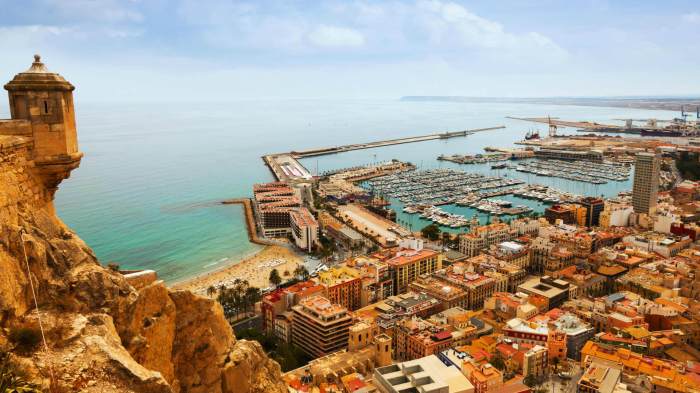
Alicante boasts a comprehensive educational system catering to diverse academic pursuits. The city is home to esteemed universities, reputable colleges, and a wide range of schools, offering a dynamic learning environment for students of all ages.
The educational landscape in Alicante is characterized by its emphasis on innovation, research, and international collaboration. The city’s universities and colleges are renowned for their cutting-edge programs, state-of-the-art facilities, and distinguished faculty.
Alicante, a coastal gem in Spain, offers an array of family-friendly attractions. From its pristine beaches to its vibrant city center, there’s something for everyone. If you’re looking for a budget-friendly getaway, consider planning a trip to Alicante. With its affordable accommodation, dining options, and budget family vacations , you can create unforgettable memories without breaking the bank.
Don’t miss out on the opportunity to explore Alicante’s rich history, culture, and natural beauty.
Universities
- University of Alicante: Founded in 1979, the University of Alicante is a vibrant and comprehensive institution with over 30,000 students. It offers a wide range of undergraduate and postgraduate programs across various disciplines, including medicine, engineering, humanities, and social sciences.
- Miguel Hernández University of Elche: Located just outside Alicante, the Miguel Hernández University of Elche is a modern and dynamic university with a focus on research and innovation. It is particularly renowned for its programs in medicine, health sciences, and engineering.
Colleges
- Higher Polytechnic School of Alicante: This prestigious college specializes in engineering and technology, offering undergraduate and postgraduate programs in various fields, including electrical engineering, mechanical engineering, and computer science.
- Faculty of Fine Arts of Alicante: The Faculty of Fine Arts of Alicante is a leading institution for the study of art and design. It offers undergraduate and postgraduate programs in fine arts, graphic design, and fashion design.
Schools
Alicante’s educational system also includes a wide range of primary and secondary schools, both public and private. These schools provide a strong foundation for students, preparing them for higher education or entry into the workforce.
Alicante, a vibrant city on the Mediterranean coast, is a popular tourist destination. If you’re looking for a unique urban experience, consider exploring the atlanta beltline , a 22-mile loop of trails and parks that circles the city. Like Alicante’s charming old town, the atlanta beltline offers a blend of history and modern amenities, connecting neighborhoods and providing a scenic escape for residents and visitors alike.
Notable Institutions, Programs, and Research Centers
- Alicante Institute of Technology: This research center focuses on developing innovative technologies in areas such as artificial intelligence, robotics, and sustainable energy.
- Oceanographic Institute of Alicante: The Oceanographic Institute of Alicante is a renowned center for marine research, specializing in marine biology, oceanography, and aquaculture.
- University Hospital of Alicante: The University Hospital of Alicante is a leading medical center in the region, providing advanced medical care and conducting cutting-edge research in various fields of medicine.
Final Summary
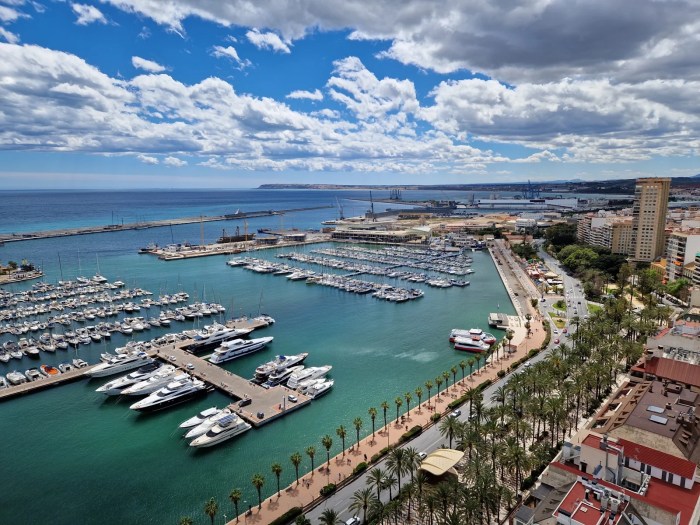
As you bid farewell to Alicante, the memories you have gathered will serve as a timeless reminder of this extraordinary city. Its captivating history, vibrant culture, and stunning natural beauty have woven a spell that will linger long after your departure. Whether you seek adventure, relaxation, or cultural immersion, Alicante has something to offer every soul. Let the spirit of this enchanting city forever reside in your heart, inspiring you to seek out more hidden gems in the world.
FAQ
What is the best time to visit Alicante?
Alicante enjoys a Mediterranean climate with warm, dry summers and mild winters. The best time to visit is during the shoulder seasons (April-May and September-October) when the weather is pleasant and there are fewer crowds.
What are the must-see attractions in Alicante?
Must-see attractions in Alicante include the Santa Barbara Castle, the Postiguet Beach, the Explanada de España, the Central Market, and the Archaeological Museum of Alicante (MARQ).
What is the local cuisine like in Alicante?
Alicante’s cuisine is influenced by its coastal location and features fresh seafood, rice dishes (such as paella), and local specialties like turrón (a nougat candy).
How do I get around Alicante?
Alicante has a well-developed public transportation system, including buses, trams, and a light rail line. You can also rent a car or bike to explore the city and its surroundings.